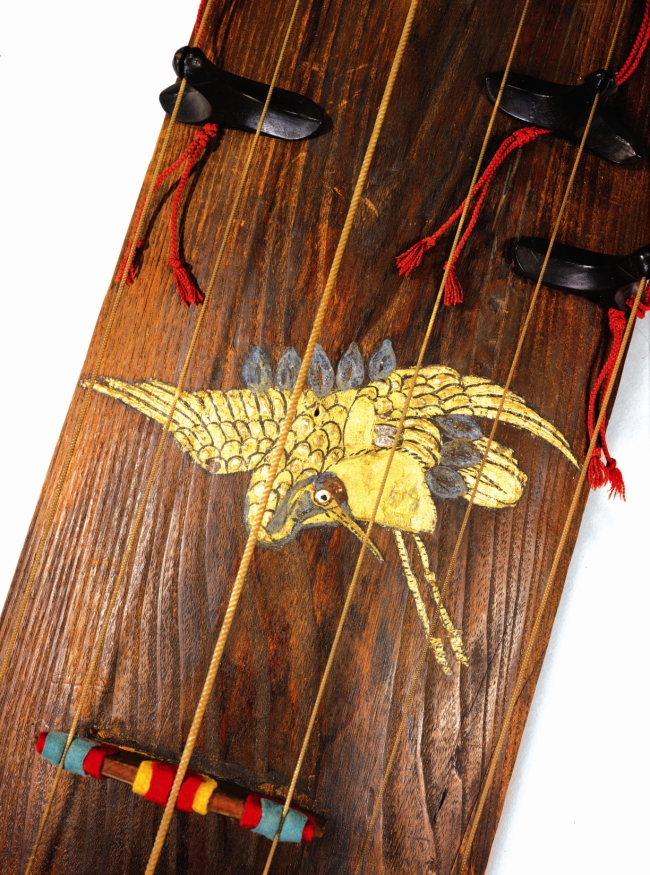Rare Korean traditional music instruments returned home from France after 112 years on display at the National Gugak Center
More than 100 years before K-pop reached Paris, Emperor Gojong (1852-1919) personally introduced Korean traditional musical instruments to the French capital.
The instruments, including “geomungo,” “”haegeum,” “piri” and “daegeum,” were showcased at the Paris International Exposition in 1900. They were carried by the delegation led by Min Young-chan, a relative of Empress Myeongseong, to the World Fair where the emperor wanted to draw international attention to the then-geopolitically isolated country. But these historic items were left behind in France because the delegation was not able to cover the expenses, about 200,000 francs, to bring them back.
After 112 years, the National Gugak Center has brought 11 of the 16 rare “gugak,” or traditional Korea music, instruments back from France, offering a rare chance for the public and experts to appreciate the historic instruments. The center opened a special exhibition titled “The Year 1900, Gugak in Paris” on Monday at its reopened museum in Yangjae-dong, southern Seoul.
More than 100 years before K-pop reached Paris, Emperor Gojong (1852-1919) personally introduced Korean traditional musical instruments to the French capital.
The instruments, including “geomungo,” “”haegeum,” “piri” and “daegeum,” were showcased at the Paris International Exposition in 1900. They were carried by the delegation led by Min Young-chan, a relative of Empress Myeongseong, to the World Fair where the emperor wanted to draw international attention to the then-geopolitically isolated country. But these historic items were left behind in France because the delegation was not able to cover the expenses, about 200,000 francs, to bring them back.
After 112 years, the National Gugak Center has brought 11 of the 16 rare “gugak,” or traditional Korea music, instruments back from France, offering a rare chance for the public and experts to appreciate the historic instruments. The center opened a special exhibition titled “The Year 1900, Gugak in Paris” on Monday at its reopened museum in Yangjae-dong, southern Seoul.

The instruments had been kept at the Instrument Museum of the Music Conservatory for a long time and were discovered by a French historian at the Museum of Music only in 2005.
Experts voiced the need to bring them back. But there was no way to transfer the ownership of the historic instruments from France to Korea because they had been officially given to France. Instead, the center decided to bring them back on loan, it said. The instruments will be returned to France after two months, according to the center.
The musical instruments must have been the best of their kind at the time because they were carefully selected by the emperor himself, said Lee Dong-bok, director general of the center.

The instruments were awarded a bronze medal by the international jury of the expo, he added.
The musical instruments are useful materials to study old Korean music because they have been well preserved by experts in France, officials said.
The shape of the instruments currently on display in Seoul is similar to today’s gugak instruments. But there are slight differences, offering clear evidence that gugak instruments have evolved in the last 100 years, an expert said.
“The haegeum upper body, for instance, was bent backward probably to add more tension to its strings. The body length of daegeum is shorter while danso has a fifth hole on the back. This implies that the way musicians performed 100 years ago was different from today,” said Joo Jae-keun, curator of the National Gugak Center.
There are more Korean historic instruments preserved and owned by foreign institutes.
“The list includes a 300 to 400-year-old geomungo on display at the Smithsonian Museum, a celadon piri, or flute, at the Metropolitan Museum of Art and a few other instruments at the Peabody Essex Museum, left in the U.S. after the World Expo in Chicago in 1893,” Joo said.
“We will also bring them back later, but on loan,” he added.
The Seoul exhibition also presents rare photos and videos of the Korean pavilion at the Paris expo where the instruments were on display. Photos of the Korean pavilion were previously exhibited but film of the fair in Korea is being shown for the first time.
The exhibition runs through Oct. 7. Admission is free. For more information, visit www.gugak.go.kr or call (02) 580-3396.
By Cho Chung-un (christory@heraldcorp.com)
-
Articles by Korea Herald







![[Graphic News] More Koreans say they plan long-distance trips this year](http://res.heraldm.com/phpwas/restmb_idxmake.php?idx=644&simg=/content/image/2024/04/17/20240417050828_0.gif&u=)
![[KH Explains] Hyundai's full hybrid edge to pay off amid slow transition to pure EVs](http://res.heraldm.com/phpwas/restmb_idxmake.php?idx=644&simg=/content/image/2024/04/18/20240418050645_0.jpg&u=20240419100350)






![[From the Scene] Monks, Buddhists hail return of remains of Buddhas](http://res.heraldm.com/phpwas/restmb_idxmake.php?idx=652&simg=/content/image/2024/04/19/20240419050617_0.jpg&u=20240419175937)

![[KH Explains] Hyundai's full hybrid edge to pay off amid slow transition to pure EVs](http://res.heraldm.com/phpwas/restmb_idxmake.php?idx=652&simg=/content/image/2024/04/18/20240418050645_0.jpg&u=20240419100350)

![[Today’s K-pop] Illit drops debut single remix](http://res.heraldm.com/phpwas/restmb_idxmake.php?idx=642&simg=/content/image/2024/04/19/20240419050612_0.jpg&u=)